
The 71st Regiment, Pennsylvania Volunteer Infantry was an infantry regiment of the Union Army that participated in the American Civil War.

The 11th Pennsylvania Infantry Regiment was a Union army regiment that participated in the American Civil War. It had the distinction of being the oldest unit in continuous service from Pennsylvania.

The 1st Ohio Infantry Regiment was an infantry regiment in the Union Army during the American Civil War. It served in the Western Theater in a number of campaigns and battles.

During the American Civil War, the Commonwealth of Pennsylvania played a critical role in the Union, providing a huge supply of military manpower, equipment, and leadership to the Federal government. The state raised over 360,000 soldiers for the Federal armies, and served as a major source of artillery guns, small arms, ammunition, armor for the new revolutionary style of ironclad types of gunboats for the rapidly expanding United States Navy, and food supplies. The Phoenixville Iron Company by itself produced well over 1,000 cannons, and the Frankford Arsenal was a major supply depot.

The 118th Pennsylvania Regiment was a volunteer infantry regiment in the Union Army during the American Civil War. They participated in several major conflicts during the war including the Battle of Gettysburg, Siege of Petersburg, and escorted the truce flag of Robert E. Lee at the Battle of Five Forks. The regiment was led by Colonel Charles Prevost until he was seriously injured at the Battle of Shepherdstown in which Lieutenant-Colonel James Gwyn assumed command until the end of the war.
The 74th Pennsylvania Volunteer Infantry was an infantry regiment which served in the Union Army during the American Civil War. It was one of many all-German regiments in the army, most notably in the XI Corps of the Army of the Potomac. Its combat record was marred by the perceived poor performance of the entire corps at Chancellorsville and Gettysburg, when parts of the corps routed during Confederate attacks.
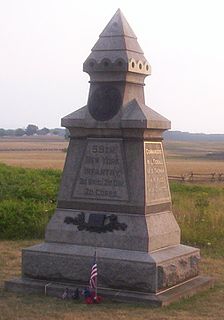
The 59th New York Volunteer Infantry Regiment was a regiment in the Union Army during the American Civil War. As part of the Second Corps of the Army of the Potomac, it played a significant role in battles such as Antietam and Gettysburg.
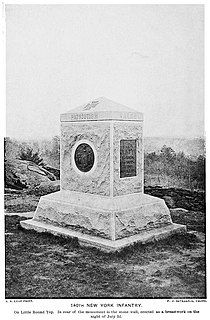
The 140th New York Volunteer Infantry Regiment was a volunteer infantry regiment that was created on September 13, 1862 for the Union Army during the American Civil War. From January 1864 they wore a Zouave uniform.
The 75th Regiment Indiana Infantry was an infantry regiment that served in the Union Army during the American Civil War.

John Wainwright was a United States military officer during the American Civil War. A native of Syracuse, New York, he was awarded his nation's highest award for valor, the Medal of Honor, for his "gallant and meritorious conduct" while serving in the Union Army as a first lieutenant with the 97th Pennsylvania Infantry during the Second Battle of Fort Fisher, North Carolina on January 15, 1865.
The following list is a Bibliography of American Civil War Union military unit histories. More details on each book are available at WorldCat.

James Gwyn was an officer in the Union Army during the American Civil War. He immigrated at a young age from Ireland in 1846, initially working as a storekeeper in Philadelphia and later as a clerk in New York City. At the onset of the war, in 1861, he enlisted and was commissioned as a captain with the 23rd Pennsylvania Volunteer Infantry. He assumed command of the 118th Pennsylvania Regiment in the course of the war. Gwyn led that regiment through many of its 39 recorded battles, including engagements at Seven Pines, Fredericksburg, Shepherdstown, Five Forks, Gettysburg, and Appomattox Court House.

The 47th Regiment, Pennsylvania Volunteer Infantry was an infantry regiment that served in the Union Army during the American Civil War.
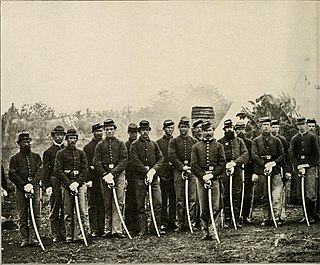
The 3rd Pennsylvania Cavalry Regiment was a cavalry regiment in the Union Army during the American Civil War.
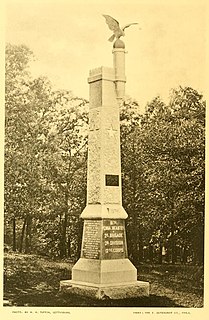
The 111th Pennsylvania Volunteer Infantry was an infantry regiment that served in the Union Army during the American Civil War.
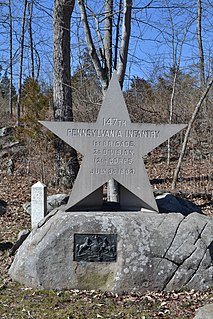
The 147th Pennsylvania Volunteer Infantry was an infantry regiment that served in the Union Army during the American Civil War.

The 12th Regiment Pennsylvania Volunteer Infantry was an infantry regiment of the Union Army in the American Civil War. Raised in Pittsburgh and its surrounding counties in April 1861 for three months of service, the regiment spent its first month in training, then guarded the Northern Central Railway in Maryland until it was mustered out. Many of its men went on to serve in subsequent Pennsylvania regiments during the war.
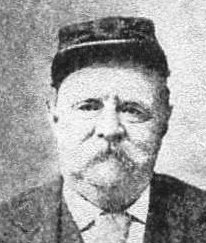
William Sands was a United States soldier who fought with the Union Army during the American Civil War as a principal musician with the 88th Pennsylvania Infantry and, later, as a first sergeant with that same regiment. He received his nation's highest award for valor, the U.S. Medal of Honor, for capturing an enemy flag and carrying it from behind Confederate States Army lines to those of the Union Army during the Battle of Dabney's Mill/Hatcher's Run, Virginia. That award was conferred on November 9, 1893.
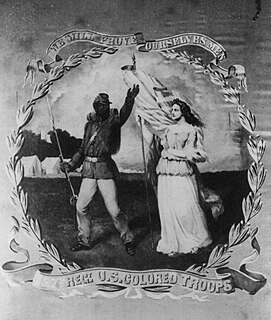
The 127th United States Colored Infantry was an American infantry regiment which fought with the Union Army during the American Civil War. Staffed by African American enlisted men who were placed under the command of white officers, the regiment was formed and trained at Camp William Penn near Philadelphia, Pennsylvania between August 23 and September 10, 1864.
Gustavus Adolphus Smith was a prosperous carriage maker in Decatur, Illinois before the American Civil War. He was a volunteer Union Army colonel from the beginning of the war until September 22, 1863 and from February 28, 1865 until December 14, 1865. After the end of the war, on January 13, 1866, President Andrew Johnson nominated Smith for appointment to the grade of Brevet brigadier general of volunteers, to rank from March 13, 1865. The United States Senate confirmed the appointment on March 12, 1866. Starting in 1870, Smith was a collector of internal revenue in New Mexico.
















